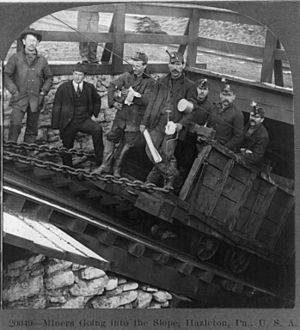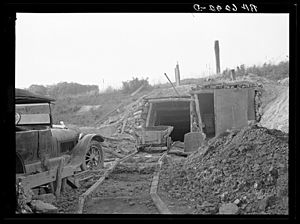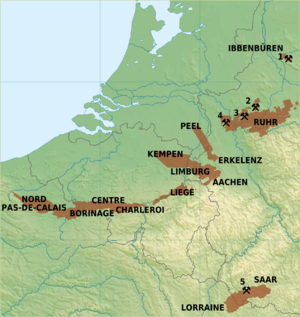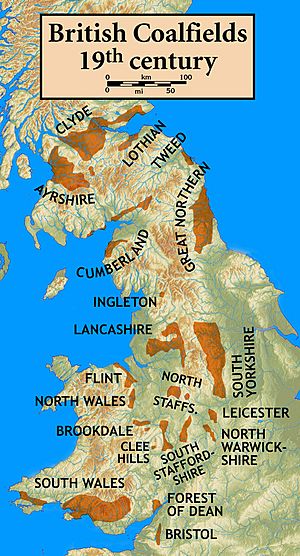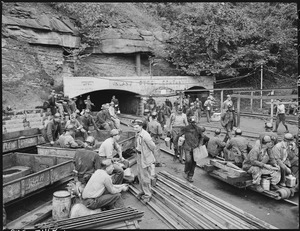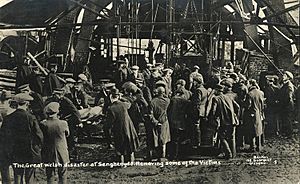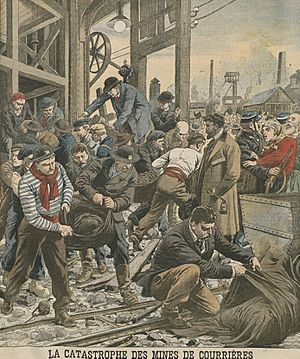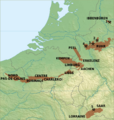History of coal mining facts for kids
The history of coal mining stretches back thousands of years. People in ancient China, the Roman Empire, and other early civilizations used coal. It became super important during the Industrial Revolution in the 1800s and 1900s. Back then, coal was mainly used to power steam engines, warm up buildings, and make electricity.
Today, coal mining is still a big part of the economy. However, its use is starting to decrease because burning coal contributes a lot to global warming and other environmental problems. This means less demand for coal in many places.
Coal gives off more energy than wood fuels for the same amount. It can also be found in areas where wood isn't common. While people used coal to heat their homes in the past, it's now mostly used in factories. It's especially important for smelting metals and making alloys, as well as for electricity generation.
Large-scale coal mining really took off during the Industrial Revolution. Coal was the main energy source for factories and transportation from the 1700s to the 1950s. Even now, coal is still a key energy source. Today, coal is also mined on a large scale using open pit methods. This happens where coal layers are close to the surface. Britain developed many of the main techniques for underground coal mining from the late 1700s onwards. But from the 1860s, oil and gas started to be used more as alternatives.
By the late 1900s, coal was mostly replaced in homes, factories, and transportation by oil, natural gas, or electricity made from other sources like oil, gas, nuclear power, or renewable energy. By 2010, coal still produced over a fourth of the world's energy.
Since 1890, coal mining has also been a big political and social topic. Coal miners' unions became very strong in many countries in the 1900s. Often, miners were leaders in Left-wing or Socialist movements. Since 1970, environmental issues have become more important. These include the health of miners, damage to the land from strip mines, air pollution, and coal's role in global warming.
Contents
Early Coal Mining
Early coal mining was done on a small scale. Coal was either found on the surface or very close to it. Common ways to get coal included drift mining (digging into a hillside) and bell pits (a shallow shaft with coal dug out around the bottom). Small shaft mining was also used. This involved a central shaft with coal dug out in a bell shape, or a method called room and pillar. In this method, "rooms" of coal were removed, and "pillars" of coal were left to hold up the roof. However, both these methods left a lot of usable coal behind.
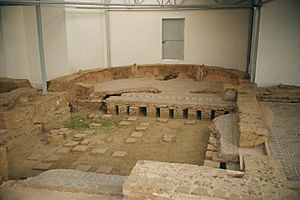
In China, old records show that people were surface mining coal and using it in their homes around 3490 BC. The first mention of coal being used to work with metals comes from a Greek scientist named Theophrastus (around 371–287 BC). He wrote that "coals are made of earth, and, once set on fire, they burn like charcoal." He noted they were used by metalworkers.
The Aztecs in the Americas were the first to use coal there. They used it for fuel and a type of coal called jet for decorations.
In Roman Britain, the Romans were using most major coalfields by the late 100s AD. While much of the coal was used locally, a busy trade grew along the North Sea coast. Coal was sent to Yorkshire, London, and even to the Rhineland in Europe. There, bituminous coal was used to melt iron ore. Romans also used coal in hypocausts to heat public baths, military forts, and wealthy homes.
After the Romans left Britain in 410 AD, there are few records of coal use until the late 1100s. By 1183, a smith was required to "raise his own coal." Soon after the Magna Carta in 1215, coal began to be traded in Scotland and northeast England. Here, coal layers were found on the seashore, so it was called "sea coal." This coal wasn't good for home fireplaces then, but artisans used it for things like lime burning and metalworking. By 1228, sea coal was being sent to London.
During the 1200s, coal trade grew across Britain. Most coalfields in England, Scotland, and Wales were being worked on a small scale. As more artisans used coal, people noticed that coal smoke was bad for health. Growing pollution in London caused problems. So, in 1306, a Royal order was given to stop London artisans from using sea coal and to go back to wood and charcoal.
Marco Polo wrote about how much coal was used in Yuan dynasty China in the late 1200s. He said coal was the main fuel and helped heat baths more than wood could.
In the early 1300s, coal started to be used for home heating in British coal-producing areas. This was because home fireplaces were improved. King Edward III was the first king to take an interest in the coal trade. He allowed coal to be exported to Calais. Demand for coal steadily increased in Britain during the 1400s. But it was still mainly used in mining areas, coastal towns, or exported. However, by the mid-1500s, wood supplies in Britain were running low, and coal quickly became a popular home fuel.
In 1575, Sir George Bruce of Carnock in Culross, Scotland, opened the first coal mine to dig coal from under the sea. He built an artificial island with a 40-foot shaft that connected to two other shafts for drainage and air. This technology was very advanced for its time.
During the 1600s, mining techniques improved. People started using test boring to find good coal deposits. They also used chain pumps, powered by water wheels, to drain water from the mines.
Some people didn't like the change from wood to coal. They preferred the smell of wood smoke. They even called coal "the devil's excrement." If the coal had a lot of sulfur, that description was quite fitting!
North American coal was first found by French explorers in New Brunswick, Canada, in the 1600s. Coal layers were visible where rivers flowed into Grand Lake. People dug coal by hand from the surface and from tunnels. By 1631, the French were sending coal to the British colony in Boston.
Coal and the Industrial Revolution
The Industrial Revolution began in Britain in the 1700s and then spread around the world. It relied heavily on coal to power steam engines. International trade grew hugely when coal-powered steam engines were built for railways and steamships during the Victorian era. Coal was cheaper and much more efficient than wood fuel for most steam engines.
Because central and Northern England had lots of coal, many mines were built there. The South Wales coalfield and Scotland also had many mines. The small-scale mining methods weren't enough for the growing demand. So, mining moved from surface digging to deep shaft mining as the Industrial Revolution continued.
As steamships traveled overseas from Europe, their need for coal led to coal mining starting in new places around the world. For example, coal mining in Zona Centro Sur, Chile, began because steamships started arriving in Talcahuano.
Coal Mining in the 1900s
At the start of the 1900s, coal production was huge worldwide. The United States and the United Kingdom were among the biggest producers. Coal was vital for industries and homes.
Coal in Australia
In 1984, Australia became the world's largest coal exporter, passing the US. A third of Australia's coal exports came from the Hunter Valley in New South Wales. Coal mining started here almost 200 years earlier. The British settlers first called the Hunter River "Coal River" when they found coal in 1795. In 1804, a convict settlement was set up near the river's mouth to mine coal. They named the town Newcastle, making it a coal port. Today, Newcastle, NSW, is the world's largest coal port.
Now, Queensland is Australia's top coal producer. Its Bowen Basin is the main source of black coal. China became the main customer for Australian coal.
Coal in Belgium
By 1830, when iron and steel became important in Wallonia, the Belgian coal industry was already well-established. It used steam engines for pumping water out of mines. The Belgian coalfields were near the navigable Meuse river, so coal could be shipped to ports and cities. The opening of the Saint-Quentin Canal in 1810 allowed coal to reach Paris by barge.
Belgian coal layers were often close to the surface, so many small mines started. As miners went deeper, gas explosions became a serious problem. Belgium had high death rates for coal miners. By the late 1800s, some coal seams were running out. In 1900, new coal was found in the Campine basin. This led to new mines opening, mainly producing coal for the steel industry.
In 1965, a plan to reorganize Belgian coal mines led to strikes. In 1966, two miners died at the Zwartberg mine. Coal was mined in the Liège basin until 1980, in the Southern Wallonian basin until 1984, and in the Campine basin until 1992.
Coal in Canada
Canadian coal mining began in New Brunswick in the early 1600s. French explorers found coal along Grand Lake. Small amounts were dug from the surface and tunnels. This coal supplied Fort Saint Marie, built by the French around 1632. The French even sold coal to the British colony in Boston as early as 1639. Grand Lake is now recognized as a Canadian Historic Site because of this early coal export.
Mining grew after the British took control in the mid-1700s. Between 1639 and 1887, about 200,000 tons of coal were dug at Grand Lake. By 1920, modern equipment like draglines made strip mining possible. The Grand Lake mines produced over 200,000 tons per year, mostly for railroads and large businesses. By 1950, production often reached 1 million tons per year. In 2009, the Grand Lake coal mines closed due to more available oil and environmental concerns.
Nova Scotia Coal
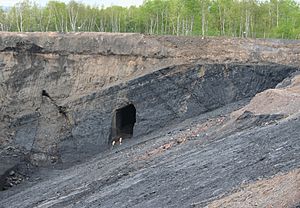
The first coal mining in Nova Scotia started in the 1700s. Small mines were dug by hand near the sea at Joggins, Nova Scotia and in the Sydney area. Large-scale mining began in the late 1830s. An English company, the General Mining Association (GMA), got a monopoly on coal mining. They brought in new technology like steam pumps and railways. They developed large mines in the Stellarton area, including the Foord Pit, which was the deepest coal mine in the world by 1866.
Coal mining also grew in Springhill and Joggins. After the GMA's monopoly ended, the biggest mines developed in Cape Breton. Nova Scotia was Canada's main coal supplier until 1945. At its peak in 1949, 25,000 miners dug 17 million metric tons of coal. Miners often lived in company towns and became active in left-wing politics to fight for safety and fair wages. The Westray Mine near Stellarton closed in 1992 after an explosion killed 26 miners. All underground mines closed by 2001, though some open pit mining continues.
Alberta Coal
Coal was easy to find in what is now Drumheller, Alberta, Canada. The Atlas Coal Mine National Historic Site is now a museum there. It shows how the Blackfoot and Cree people knew about the "black rock that burned." After settlers reported coal, ranchers and homesteaders dug it for their homes. Sam Drumheller started a coal rush when he bought land and sold it to the Canadian National Railway.
By the end of 1912, there were nine working coal mines in the area. More mines opened later. The timing was good because the United Mine Workers union had recently won better working conditions. Child labor laws were passed to stop boys under 14 from working underground.
Miners' camps were tough places at first, called "hell's holes." But conditions improved, and families moved in. The camps became lively towns with activities like hockey and baseball. Between 1911 and 1979, 139 mines were registered in the Drumheller Valley. The discovery of oil in 1947 led to natural gas becoming the main fuel for heating homes. As coal demand dropped, mines closed, and some communities disappeared.
The Atlas #4 Mine shipped its last coal in 1979. The Atlas Coal Mine National Historic Site now preserves the last of the Drumheller mines. The East Coulee School Museum also teaches visitors about life in the mine towns.
Coal in China
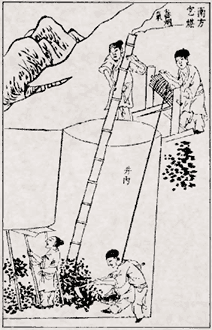
The coal industry in China has a very long history. In recent decades, it has become the main energy source for China, which is the world's second-largest economy. China is by far the biggest producer of coal in the world. In 2007, it produced over 2.8 billion tons, about 39.8% of all coal worldwide. For comparison, the United States, the second-largest producer, made over 1.1 billion tons in 2007.
An estimated 5 million people work in China's coal-mining industry. Sadly, as many as 20,000 miners die in accidents each year. Most Chinese mines are deep underground and don't cause the surface damage seen with strip mines.
Coal in France
Pierre-Francois Tubeuf started the modern coal industry in France in 1770. Unions for miners appeared in the late 1800s, focusing on safety. In 1885, there were 175 injuries for every thousand workers each year. Deaths were usually low (2 per 1000 workers), but big disasters were always a risk. For example, 1099 men died in the Courrières mine disaster in 1906.
The fight for mine safety helped miners unite and develop a strong working-class identity. Unions gained power by setting up a system where workers elected mine-safety representatives. The government supported the safety movement to reduce conflicts in the coal fields. Still, strikes were common, and coal miners became leaders in political organizing.
Coal in Germany
The first important mines in Germany appeared in the 1750s. They were in the valleys of the Ruhr, Inde, and Wurm rivers, where coal layers were close to the surface. In 1782, the Krupp family started mining near Essen. After 1815, business owners in the Ruhr Area opened new mines and iron factories. New railways were built around 1850. Many small industrial centers grew, focusing on ironworks that used local coal.
Iron and steel companies often bought mines and built coking ovens to get their own coke and gas. These combined coal-iron companies became common after 1854. By 1900, they became larger "Konzern" companies.
The average mine produced about 8,500 short tons in 1850 and employed about 64 people. By 1900, the average mine produced about 280,000 short tons and employed about 1,400 people. Total Ruhr coal output grew from 2 million short tons in 1850 to 114 million short tons in 1913. Output peaked in 1957 at 123 million short tons. By the end of 2010, five coal mines were still producing in Germany. The last hard coal mine in Germany closed on December 21, 2018.
Miners in the Ruhr region were divided by their backgrounds (Germans and Poles) and religions (Protestants and Catholics). Miners often moved between mining camps and nearby industrial areas. They joined different unions, each linked to a political party. After 1945, the socialist union became the most important.
Coal in India
Coal was not well known in India during the Mughal rule. Commercial mining began in 1774. John Sumner and Suetonius Grant Heatly of the East India Company started operations in the Raniganj Coalfield. Demand grew slowly until 1853, when steam locomotives were introduced to the expanding rail system.
As late as 1895, India imported a lot of coal from Britain. But as India's own production grew and was found suitable for trains and ships, coal imports dropped sharply. India's coal exports increased, especially to Burma, Ceylon, and the Malay states.
By 1900, production reached 6.12 million tons per year, and 18 million tons by 1920. After India became independent, the government focused on growing heavy industry. The National Coal Development Corporation was founded in 1956. This was a big step in developing India's own coal sector. The huge Dhanbad coal-mining area became very important.
Coal in Poland
The first permanent coal mine in Poland was set up in Szczakowa near Jaworzno in 1767. In the 1800s, the growth of iron, copper, and lead mining in southern Poland led to a quick development of coal mining. Important coal deposits are in the Upper Silesian Industrial Region and Rybnik Coal Area.
Today, coal is still a key resource for Poland's economy, meeting about 65% of its energy needs. Before and after World War II, Poland was one of the world's major coal producers, often in the top five. However, since 1989, coal production has been declining.
Coal in Russia
From the 1860s, large coal deposits in the Don Basin ("Donbas") in southern Russia supplied 87% of Russia's coal. It was used by railways and the iron and steel industry. After 1900, smaller deposits were opened in Siberia. Coal production was controlled by companies that weren't very efficient, and there weren't enough workers. This slowed down the growth of Russian heavy industry.
During World War II, Russia lost 60% of its mining areas to German invaders. This forced a quick expansion of mines in the Urals and more use of mines in Siberia. Prisoners from the Gulag were sent to the mines, and up to a third of the workers were women. Miners were given much more food. Coal output doubled, and the Urals' share of national coal production rose from 8% to 22%.
In 1989-1991, strong coal miners in Russia and Ukraine were a key force that helped overthrow the Communist system in 1991. Today, the Donets Basin is a major coal-mining area in eastern Ukraine and parts of Russia.
Coal in the United Kingdom
Before 1900
While some deep mining happened as early as the 1500s, deep shaft mining in the UK really grew in the late 1700s. It expanded quickly throughout the 1800s and early 1900s, when the industry was at its peak. The location of the coalfields helped make areas like Lancashire, Yorkshire, and South Wales rich. The Yorkshire pits were about 300 feet deep. Northumberland and Durham were top coal producers and had the first deep pits. In much of Britain, coal was dug from drift mines or scraped from the surface. Small groups of part-time miners used shovels and simple tools.
Scottish miners were tied to their "maisters" (masters) by a 1606 law. A later law in 1775 recognized this as "a state of slavery" and officially ended it. This was made effective by another law in 1799.
Before 1800, a lot of coal was left in the ground because mining was still basic. In deep Tyneside pits (300 to 1,000 feet deep), only about 40% of the coal could be removed. Using wooden pit props to support the roof was a new idea around 1800. A key challenge was getting air to circulate and controlling dangerous explosive gases. At first, fires were lit at the bottom of a shaft to create air currents. Later, fans powered by steam engines were used. Miners got protection with the invention of the Davy lamp and Geordie lamp. These lamps allowed firedamp (or methane) to burn safely inside the lamp, preventing explosions. However, the light from these lamps was very dim.
Coal was so plentiful in Britain that production could increase quickly to meet demand. In 1700, annual coal output was just under 3 million tons. By 1830, it had risen to over 30 million tons. Miners, who were less affected by imported labor or machines than factory workers, started forming trade unions. They fought hard for better wages against coal owners.
Using women and children (who were paid much less than men) was common until a law in August 1842 stopped it. In South Wales, miners were very united. They lived in isolated villages where most people were miners. They had a strong sense of equality and worked together to form a "community of solidarity" under the leadership of the Miners Federation.
Since 1900
Keeping coal supplies steady was important in both world wars. Coal also became a very political issue because of the tough conditions miners worked in and how they were treated. Much of the 'old Left' in British politics came from coal-mining areas. The main union was the Miners' Federation of Great Britain, founded in 1888, which had 600,000 members in 1908.
One reason for the UK General Strike of 1926 was miners' worries about very dangerous working conditions, lower pay, and longer shifts.
New technology throughout the 1800s and 1900s helped make mines safer and more productive. In the late 1900s, coal stayed important for making electricity, even with new energy sources like oil, natural gas, and nuclear power. More recently, coal has faced competition from renewable energy sources.
Most British coal mines were bought by the government in 1947 and put under the control of the National Coal Board. The miners' union had pushed for this for decades. Under the leadership of Alf Robens, many pits closed as coal's role in energy production declined. The union leadership tried to avoid strikes, but an unofficial strike began in 1969. This led to more money being spent on the coal industry and a slower rate of mine closures.
Under Prime Minister Ted Heath, an official strike in 1972 won higher wages. Less than two years later, Heath called a general election over another official strike. He lost the election, and the new government met the wage demands. Spending on the industry continued to increase.
By the early 1980s, many pits were nearly 100 years old and were considered too expensive to run compared to cheap North Sea oil and gas. The Miners' Strike of 1984 failed to stop the Conservative government's plans to shrink the industry. The National Coal Board (later British Coal) was privatized in the mid-1990s. Because of used-up coal seams, high prices, and cheap imports, the mining industry almost completely disappeared.
In January 2008, the last deep pit mine in the South Wales Valleys, Tower Colliery, closed because the coal was exhausted. Kellingley Colliery was the last deep coal mine in the UK. It closed on December 18, 2015, ending deep coal mining in the UK.
Coal in the United States
Anthracite (or "hard" coal) was clean and smokeless. It became the preferred fuel in cities, replacing wood by about 1850. Bituminous (or "soft coal") mining came later. After 1850, soft coal, which was cheaper but dirtier, was in demand for railway locomotives and stationary steam engines. It was also used to make coke for steel after 1870.
Total coal output grew hugely until 1918. Before 1890, it doubled every ten years. It went from 8.4 million short tons in 1850 to 270 million in 1900, peaking at 680 million in 1918. New soft coal fields opened in Ohio, Indiana, Illinois, West Virginia, Kentucky, and Alabama. The Great Depression of the 1930s lowered demand.
Under John L. Lewis, the United Mine Workers (UMW) became very powerful in the coal fields in the 1930s and 1940s. They won high wages and benefits for miners. In 1914, there were 180,000 anthracite miners. By 1970, only 6,000 remained. At the same time, steam engines were phased out in railways and factories. Bituminous coal was then used mainly for making electricity. The number of workers in bituminous mining peaked at 705,000 men in 1923. It fell to 140,000 by 1970 and 70,000 in 2003.
In the 1960s, coal production shifted from small companies to larger, more diverse firms. Several oil companies and electricity producers bought coal companies. Concerns grew that competition in the coal industry might decrease. Coal prices rose sharply after the 1973 oil crisis. Prices fell in the 1980s, partly because of oil prices, but mainly because of a large increase in coal supply worldwide. During this time, the US industry moved towards low-sulfur coal.
In 1987, Wyoming became the largest coal-producing state. It uses only strip mining. Wyoming has about 69.3 billion short tons of coal reserves. In 2008, competition was strong in the US coal mining industry. Some US mines were closing. Other coal-producing countries also increased production to compete for traditional US export markets. Coal is mainly used to generate electricity. But a rapid drop in natural gas prices after 2008 created strong competition.
Other Coal-Producing Countries
In the 2000s, Indonesia greatly expanded its coal mining. By 2011, it ranked among the top five global producers. By 2011, Kazakhstan was also in the top ten for coal production and reserves. Lignite ("brown coal") remains important, with Germany, China, and Russia being the largest producers.
Mining Disasters
Mining has always been very dangerous. This is due to explosions, roof collapses, and the difficulty of rescuing people underground. The worst single disaster in British coal mining history was at Senghenydd in the South Wales coalfield. On October 14, 1913, an explosion and fire killed 436 men and boys. Only 72 bodies were found. Most explosions were caused by firedamp (methane) igniting, followed by coal dust explosions. Deaths were mainly caused by carbon monoxide poisoning, known as afterdamp.
The Mitsubishi Hojyo coal mine disaster happened on December 15, 1914, in Japan. It killed 687 people, making it the worst mining incident in Japanese history. The Courrières mine disaster in France, Europe's worst mining accident, killed 1,099 miners on March 10, 1906. The Benxihu Colliery accident in China on April 26, 1942, killed 1,549 miners.
Besides disasters directly in mines, there have been tragedies caused by mining's impact on the land and communities. The Aberfan disaster in 1966 buried a school in South Wales when a huge pile of mining waste collapsed. It killed 116 children and 28 adults.
Images for kids
See also
- Coal mining
- History of coal miners
- Mining disasters
- Child labour in coal mines


